Acars first became available to aquarists in the 70s of the XX century and today are one of the most sought-after cichlids. Fish have high intelligence, are able to recognize the owner, and sometimes allow themselves to be stroked.
General information
The name of the genus is translated from Latin as “stream”. Probably, the fish got this name for the stunning pearl and turquoise color of the muzzle and gill covers, reminiscent of the glare of a running stream on a clear sunny day. The content of cancer has a certain specificity because, in nature, fish are predators and often have an unbearable character.
Appearance
Akar`s are fish with a large and elongated body, growing up to 30 cm long. A distinctive feature is the presence of ahead with a large convex forehead, thick lips, and expressive eyes. The anal and dorsal fins are elongated. These fins, as well as the caudal fins, often have a border.
The coloration of juveniles is more than modest: the body color is gray with dark stripes. But as they grow older, the full potential of color is revealed, and Akara becomes extremely picturesque.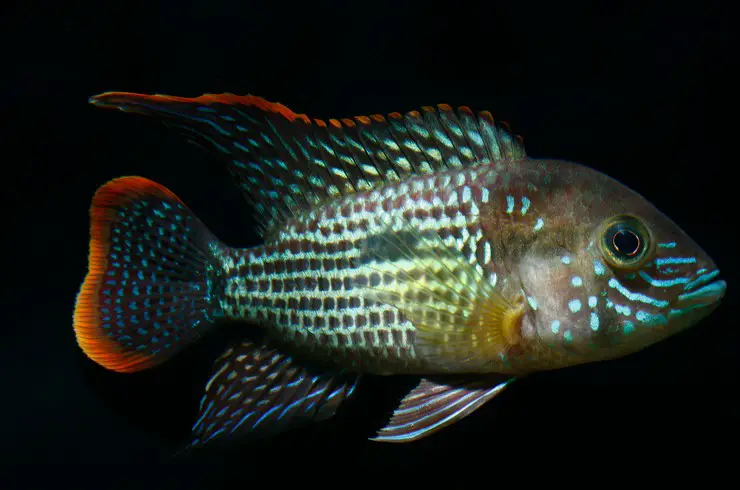
The colors can be very varied. A common symptom is the presence of shiny patches all over the body. Males are larger than females and have longer fins. Females are more modestly colored, not as bright, and the fins are more rounded. At the age of about 5 years, a wen may appear on the male’s head, which scares some aquarists, but this phenomenon is normal and is not associated with a disease.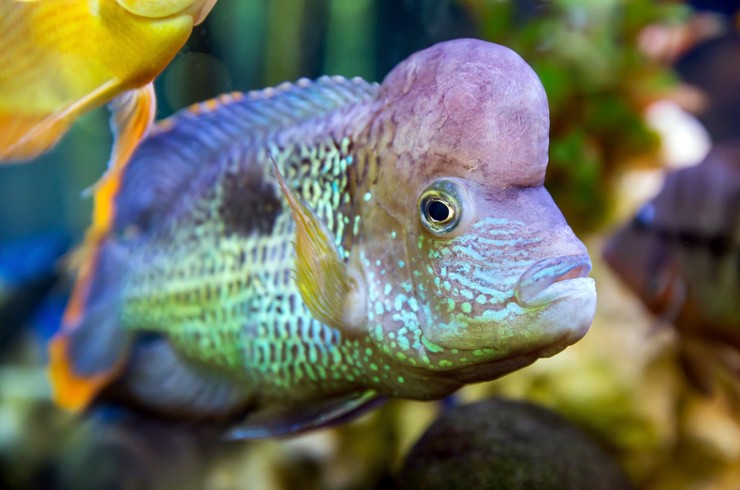
Habitat
The historical habitat of cancer is considered to be the northwestern part of Peru and the basin of the Rio Esmeraldas River. From here, their further spread to other parts of South America began, and now they can be found without problems in Central Colombia, Brazil, and neighboring countries. Akar`s live mainly in reservoirs with weak currents and a large number of living vegetation and shelters – this allows, if necessary, to hide, primarily from stronger relatives.
Care and maintenance
Most types of cancers are very large fish, therefore, the volume of the aquarium on average should be at least 100-150 liters per fish. Medium pebbles are the most suitable substrate. It is better if the stones do not have sharp edges, because many members of the genus love to dig in the ground. Acars look very good with snags and live plants, however, it is better to choose hard-leaved ones and fix them in pots, otherwise, there is a high probability that the Akar`s will dig them out. It is best to plant plants along the walls so that cancer has a large open space for swimming. Among other plant species, it is best to give preference to Anubias, Echinodorus, and Cryptocorynes. Numerous shelters will allow the fish to hide from the excessive aggressiveness of their relatives.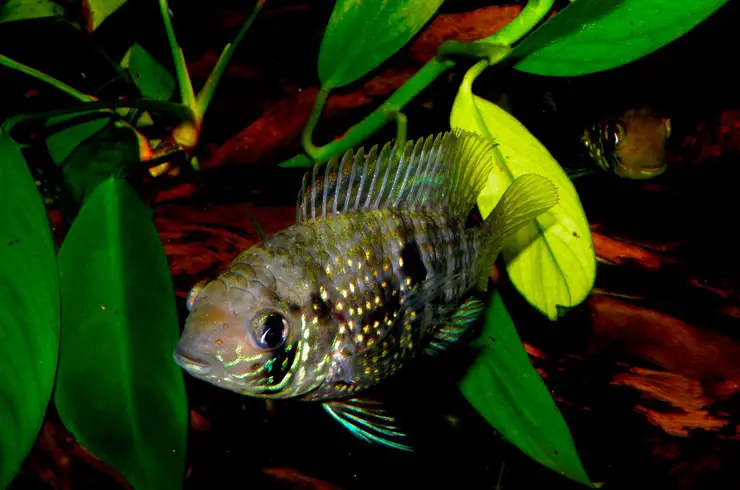
A good filtration system must be installed in the aquarium. It is best if it is a powerful external filter. Do not forget about the enrichment of water with oxygen, large and active cancer loves good aeration. Daylight hours should be up to 10 hours, at night it is best to use a special blue backlight. With a properly selected spectrum of lamps, the glowing points on the body of cancer will flash very brightly. In addition, this regime has a positive effect on fish activity and reproduction rates.
Aquarium water parameters play an important role in caring for fish, so regular testing is a good rule of thumb. The average comfort parameters for cancer will look like this: hardness – 8-15 °; pH – 6.0-8.0; temperature – 22-25 ° С. Requires weekly water changes of 20% of the tank volume. The slower the freshwater is added, the better. Sudden changes in parameters can adversely affect the health of the fish. Before pouring tap water into the aquarium, we recommend treating it with preparation to remove harmful compounds, such as Tetra AquaSafe.
Thus, keeping cancer, in general, is not particularly difficult, but it is not recommended to start such fish for novice aquarists.
Compatibility
Among the vast group of cancers, there are both relatively calm and rather aggressive species. The level of aggression directly depends on the volume of the aquarium, as well as on the period of life. For example, during spawning, even calm species begin to behave very cockily.
Akara’s are fish that tend to provoke other fish to fight. The most amazing thing is that the main “fighters” of these cichlids are females. During the period of protection of the eggs, the female rushes to anyone who dares to approach the cherished eggs. Therefore, the general recommendation would be to keep fish in pairs, without adding other species to them.
If you want to create a common aquarium with other species, then it is advisable to immediately choose young fish and raise them together. Accustomed to each other, fish will be more loyal to each other. Good neighbors for cancer will be Chromis, serums, three-hybrid parrots, astronomies, Managua cichlazomas, catfish: cynodonts, pterygoplichta.
Keeping cancer with invertebrates is inappropriate – snails and shrimps will sooner or later become live food for cichlids.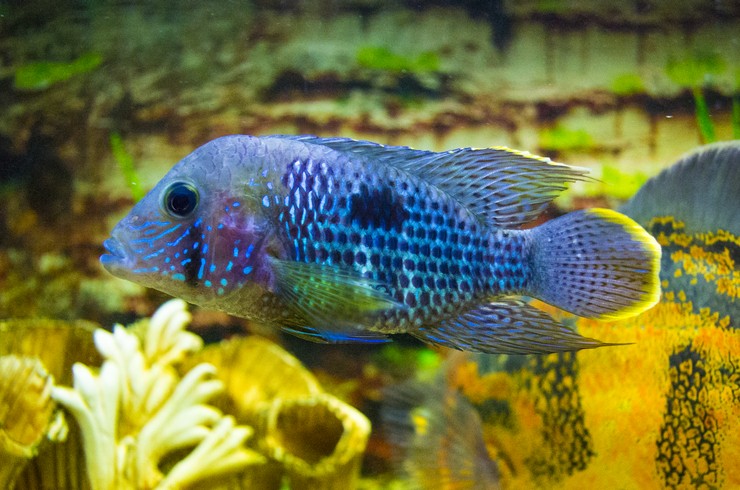
Feeding
All Akar`s are predators. In the natural environment, the basis of their diet is small fish, mollusks, worms, insects, and their larvae. When kept at home, aquarists usually use various natural live and frozen foods (bloodworms, brine shrimp, etc.) or prepare minced meat based on beef liver on their own. Unfortunately, such food can hardly be called complete and balanced. Therefore, the best choice for feeding cancer will be high-quality dry food.
Tetra offers a wide range of Tetra Cichlid food for cichlids. In it, an aquarist can easily find the right food for their cancer, taking into account the size and nutritional requirements of the fish. For example, floating food in the form of Tetra Cichlid Sticks is best suited for large arms, for dwarf species it is better to stay on microgranules – Tetra Cichlid Mini Granules. It should be noted that Tetra foods are a complete food, i.e. contain all the essential nutrients and vitamins that fish need.
Reproduction and breeding
Cancer is pubertal at about one year of age. Couples are strong, created at a young age. It is very difficult to reduce adult cancers; the male often clogs the female. Spawning can occur both in the general aquarium and in the spawning grounds. There is no need to create special conditions, but spawning can be stimulated by increasing the proportion of high-protein feed in the diet and raising the temperature by several degrees.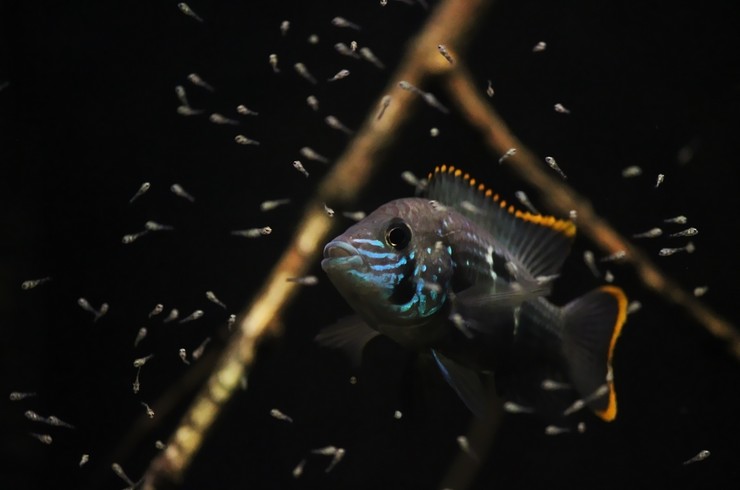
The eggs are deposited on a flat substrate – stones, driftwood, a glass of the aquarium. The fecundity of the female is up to 300-400 eggs.
Caring for offspring is characteristic. During the breeding season, the general aggressiveness of the fish increases.
